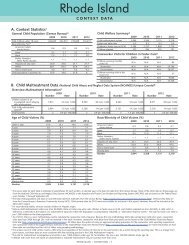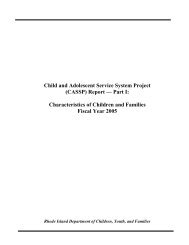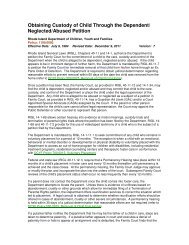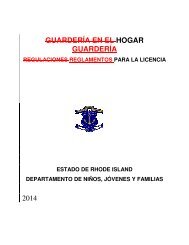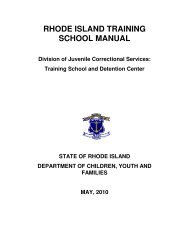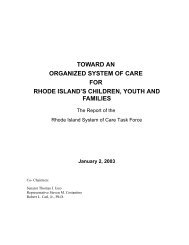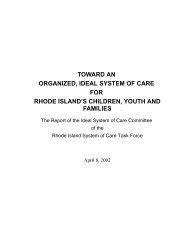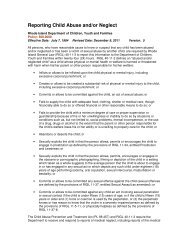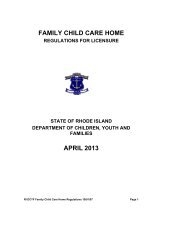CFSP 5 Year Plan - RI Department of Children, Youth & Families
CFSP 5 Year Plan - RI Department of Children, Youth & Families
CFSP 5 Year Plan - RI Department of Children, Youth & Families
Create successful ePaper yourself
Turn your PDF publications into a flip-book with our unique Google optimized e-Paper software.
During the implementation <strong>of</strong> the 2005-2009 five year plan, there was a marked change in<br />
the volume <strong>of</strong> families requiring<br />
DCYF intervention. In the<br />
following table, data as <strong>of</strong><br />
December 31 for the past three<br />
years represent a steady decline<br />
in active caseloads and in the<br />
number <strong>of</strong> children in substitute<br />
care.<br />
Active Caseloads – Number <strong>of</strong> <strong>Children</strong><br />
As <strong>of</strong> December 31 2006 2007 2008<br />
# Active Caseloads 9,414 8,843 8,203<br />
# <strong>Children</strong> in Substitute Care 3,311 3,042 2,654<br />
# <strong>Children</strong> at Home 3,418 3,138 2,824<br />
At the same time, the number <strong>of</strong> children able to be maintained in their own homes under<br />
DCYF supervision was greater than the number <strong>of</strong> children placed in foster care in each year.<br />
These trend lines represent steady progress for the <strong>Department</strong>, as throughout this period there was<br />
ongoing preparation with staff and the provider community toward greater emphasis on home and<br />
community-based services. Much <strong>of</strong> this emphasis was focused on the front-end <strong>of</strong> the<br />
<strong>Department</strong>’s service system – helping child protection investigators to work more diligently with<br />
families and community providers to avert families from being opened to the DCYF wherever<br />
possible and appropriate.<br />
LARGER SYSTEM ENHANCEMENTS –<br />
The <strong>Department</strong> <strong>of</strong> <strong>Children</strong>, <strong>Youth</strong> and <strong>Families</strong> is now one <strong>of</strong> four state departments<br />
serving children and families under the umbrella <strong>of</strong> the Executive Office <strong>of</strong> Health and Human<br />
Services (EOHHS). The EOHHS was statutorily created in the 2006 legislative session.<br />
The EOHHS is now comprised <strong>of</strong> the <strong>Department</strong>s <strong>of</strong> <strong>Children</strong>, <strong>Youth</strong> and <strong>Families</strong>;<br />
Human Services; Mental Health, Retardation and Hospitals; and Elderly Affairs. During State<br />
Fiscal <strong>Year</strong> 2009, the State received authorization from the Center <strong>of</strong> Medicare and Medicaid<br />
Services (CMS) to implement a Consumer Choice Global Medicaid Waiver which is designed to<br />
consolidate all <strong>of</strong> the State’s Medicaid funded services under the broad reach <strong>of</strong> the global waiver<br />
to ensure a community-based system <strong>of</strong> care that will greatly reduce reliance on residential<br />
treatment or other long-term institutional care – with the intent to provide more flexibility in the<br />
delivery <strong>of</strong> home and community-based services. The EOHHS has responsibility for coordinating<br />
administration and financing <strong>of</strong> Medicaid benefits across the four departments.<br />
The agencies are currently focusing on the necessary tasks to prepare for implementation<br />
through various work groups that are identifying and designing data systems changes and work<br />
flow strategies that are needed to meet various data tracking requirements and match service needs<br />
to the populations.<br />
As part <strong>of</strong> this overall system transformation, the <strong>Department</strong> is continuing its efforts to<br />
fully redesign its Integrated System <strong>of</strong> Care through a two-pronged approach: 1) the<br />
establishment <strong>of</strong> Family Care Community Partnerships (FCCPs) to address the front-end needs <strong>of</strong><br />
the child welfare and children’s behavioral health systems; and, 2) a redesign <strong>of</strong> residential<br />
R.I. <strong>Department</strong> <strong>of</strong> <strong>Children</strong>, <strong>Youth</strong> and <strong>Families</strong><br />
Title IV-B Child and Family Service <strong>Plan</strong> – 2010 - 2014<br />
3




